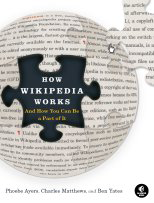
How Wikipedia Works
And How You Can Be a Part of It
Phoebe Ayers, Charles Matthews, and Ben Yates
September 2008, 536 pp.
No Starch Press
http://www.nostarch.com
US $29.95
ISBN-13 978-1-59327-176-3
Encyclopedias, those big books that have attempted to summarize all human knowledge, have been around since the time of the ancient Greeks. Pliny the Elder probably had an easy time of it, since the sum of all human knowledge was a bit smaller in his day than in ours. Denis Diderot, a now obscure French philosopher who lived in the 18th century, gave encyclopedia writing the ol’ college try. Most MyMac.com readers would be more familiar with Funk and Wagnalls, the World Book, and the Encyclopedia Britannica, if not their door-to-door salesmen.
Wikipedia is the 21st century answer to a printed book written by a relatively small group of experts. It’s a online collaborative encyclopedia that anyone can write for. Articles can be edited by almost anyone, so articles acquire a sense of consensus that traditional printed works can’t achieve.
While Wikipedia may seem like an intellectual free-for-all, there actually is a structure to the best articles. So, if you’ve got some expertise on a particular subject, and want to write about it for Wikipedia, you need to know how to do it correctly. You could read the various FAQs for hours on end, or you could read How Wikipedia Works.
How Wikipedia Works is a comprehensive guide to both using Wikipedia and writing Wikipedia articles. The book’s four parts and seventeen chapters provide a detailed treatment of the vast enterprise that is Wikipedia. You’ll come away with a firm grasp of the best ways to use, and write for, Wikipedia.
The bulk of the book focuses on writing for Wikipedia. How Wikipedia Works begins by teaching you the main tenets of Wikipedia authorship: Verifiability, No Original Research, and Neutral Point of View. If you understand and incorporate these three points, your article will  be on the way to being well-received.
Chapter Two goes back in time, and shows the history of encyclopedias, and how Wikipedia fits into this tradition.
Chapter Three brings the reader up to speed on finding content in Wikipedia.
Part II, Editing, contains the meat of the book. Here are the important concepts and details about what makes a good Wikipedia article, and how to write one. The book covers the mechanics of the editing window, how to do major or minor edits, who can edit, and much more.
How Wikipedia Works is 536 pages from stem to stern, and it’s densely packed. It’s not a novel, and I couldn’t read it through from start to finish. Readers may find it more useful to skim the book first to grasp the fundamentals, then use it later as a reference guide before and during the Wikipedia writing process. My main complaint is that the book is typeset in the font Avenir, which is a sans-serif font. I found it induced eye fatigue within half an hour.
I have one other nit to pick. The cover says that purchasers get a free online version of How Wikipedia Works from O’Reilly’s Safari Books Online. However, when you register there, you’ll be disappointed to find that you get a free 45 day trial, after which you need to subscribe to the service. The blurb should be edited to tell readers that they get a free 45 day trial.
Conclusion.
How Wikipedia Works is a fine reference guide to writing articles for Wikipedia. If you’ve ever had the urge to add your two bits to Wikipedia, get this book. Your contribution will be written according to Wikipedia’s guidelines, and so will be taken more seriously.
email – MyMac Magazine – Twitter – Advertise – Reviews Archive – Podcast

Leave a Reply
You must be logged in to post a comment.